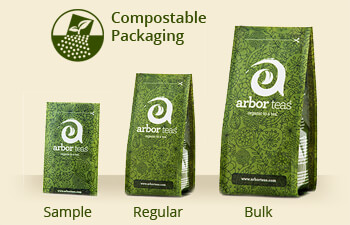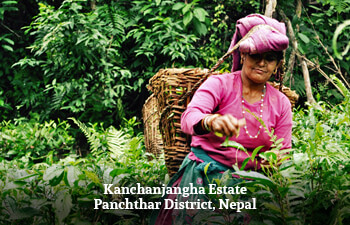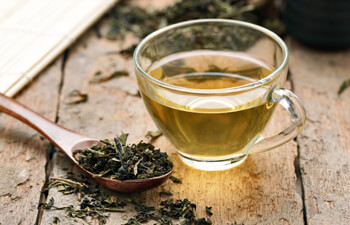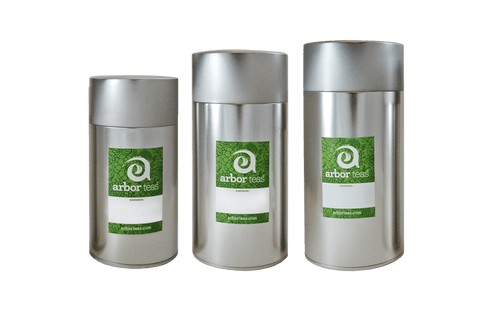Organic Nepal Green Tea

While Nepal is not one of the world's traditional tea-producing countries, it is an up-and-coming region growing high quality organic loose leaf tea with a strong commitment to social and environmental sustainability. The slightly twisted leaves of this organic Nepalese tea were grown on the Kanchanjangha Tea Estate, situated at an altitude between 3900 and 5400 feet above sea level, and yield a golden infusion.
The wet leaves of our newest lot of this organic green tea offer a sweet aroma of citrus fruit that translates into a smooth, dry, and bright cup with toasted notes. In fact, we would summarize this tea as a Nepali version of a Darjeeling First Flush. Not surprising due to the estate's close proximity to the Darjeeling region of India!
Ingredients: organic Nepalese green tea
Origin: Kanchanjangha Estate, Panchthar, Nepal

High altitudes and hilly tea gardens have made Nepal an important country for tea production. Tea has been growing here since the 1800s, and in the 1900s Nepal supplied parts of Darjeeling with tea. Often interchanged for one another on the market, tea from Darjeeling and Nepal do have different flavor profiles and Darjeeling has gone to great lengths to try to distinguish itself from its close neighbor. Orthodox tea production in Nepal has had a great influence on its economy, with many farmers transitioning to growing only tea. The Kanchanjangha Tea Estate and Research Center is considered to be one of the pioneers of organic farming in Nepal and is also the first certified organic tea garden in Nepal. It is located in Ranitar in the remote hilly region of Panchthar district. Today, more than 600 farmers are employed by the Kanchanjangha Tea Estate which provides free schooling for their children and free housing for all.
Read our field notes from our visit to Kanchanjangha!
Steeping Instructions

At Arbor Teas, we believe tea should be brewed to suit your personal taste. We’re happy to make recommendations to get you started, but don’t hesitate to experiment! When brewing your tea, your main considerations are tea quantity, water temperature, and steeping time. We recommend green and white teas to be steeped for 2 to 3 minutes in water heated to not-quite-boiling, just as bubbles begin to form on the bottom of the pan (approximately 170 to 180 degrees F). For the best flavor, use fresh water whenever possible. Try not to steep your tea longer than necessary, as you’ll extract undesirable bitterness from the leaves. If you want a stronger brew, don’t steep longer, just use more tea. And don’t forget to re-steep your tea leaves to get the most out of your leaf!
Looking for more info? Check out our How-To Guides and Eco-Brewing Tips!
Staff Perspectives
 Aubrey
Aubrey
"This green tea almost reminds me of a very green oolong, with its complex combination of flavors and aromas."
Health Benefits

Like all true tea, green tea offers many potential health benefits. Research has found that tea (Camellia sinensis) can have many positive effects on human health, including improved cardiovascular function, cancer risk reduction, improved immune function, improved oral health, and help with weight management. Tea is also full of polyphenols, which are a class of antioxidant that help your body maintain homeostasis and balance your stress levels.
Green tea specifically is known for its array of health benefits, which have been supported by a growing number of studies. Green tea research has demonstrated that it may be an effective anticancer agent for breast cancer, lung cancer, kidney cancer and prostate cancer, among others. Studies have shown a link between green tea and weight loss, and the ability to modulate energy metabolism, aid in body fat regulation, and possibly promote preferential loss in abdominal fat. Research has also shown that green tea may increase performance for short term memory tasks, as well as being increasing potency of antibiotics. Other peer-reviewed studies link green tea to healthy skin, help with lowering cholesterol, and regulating diabetes. It’s important to keep in mind that many of these studies monitor subjects who drink several cups of green tea per day.
For more information about the health benefits of green tea, and for direct sources of the above information, check out our Tea Health Benefits page!
Please note: the information above is for educational purposes only and has not been evaluated by the Food and Drug Administration. This information is not intended to diagnose, treat, cure, or prevent any disease.









